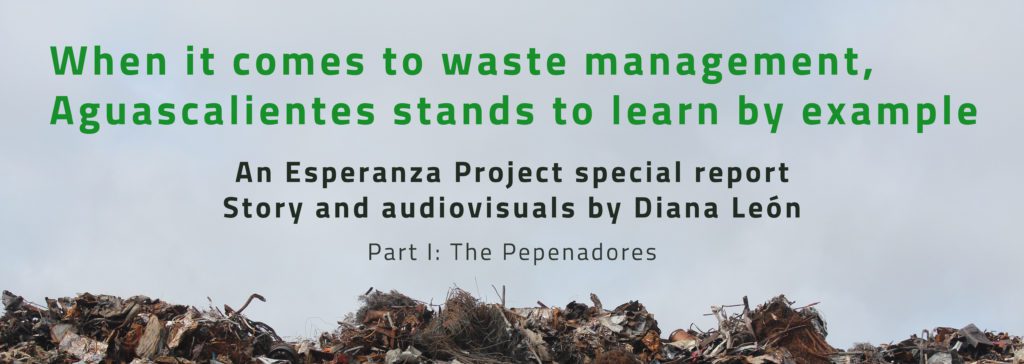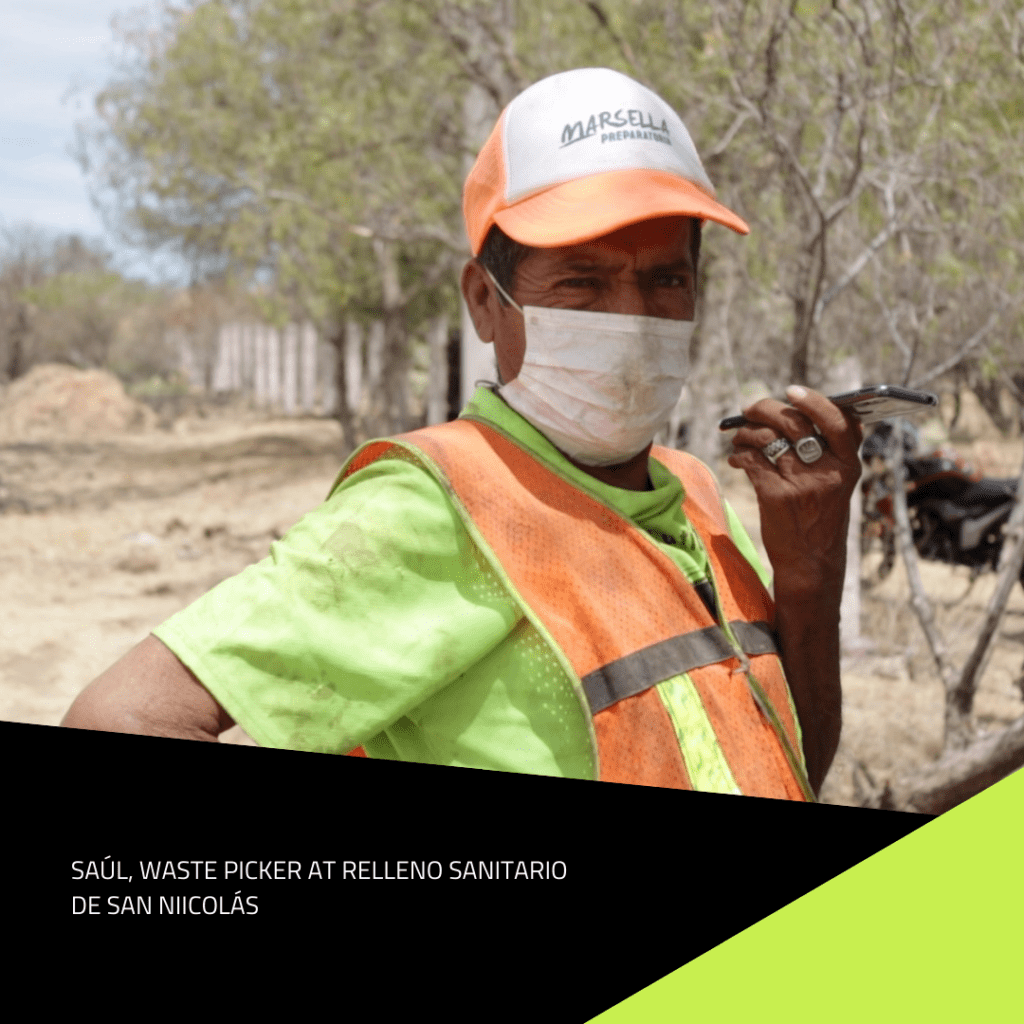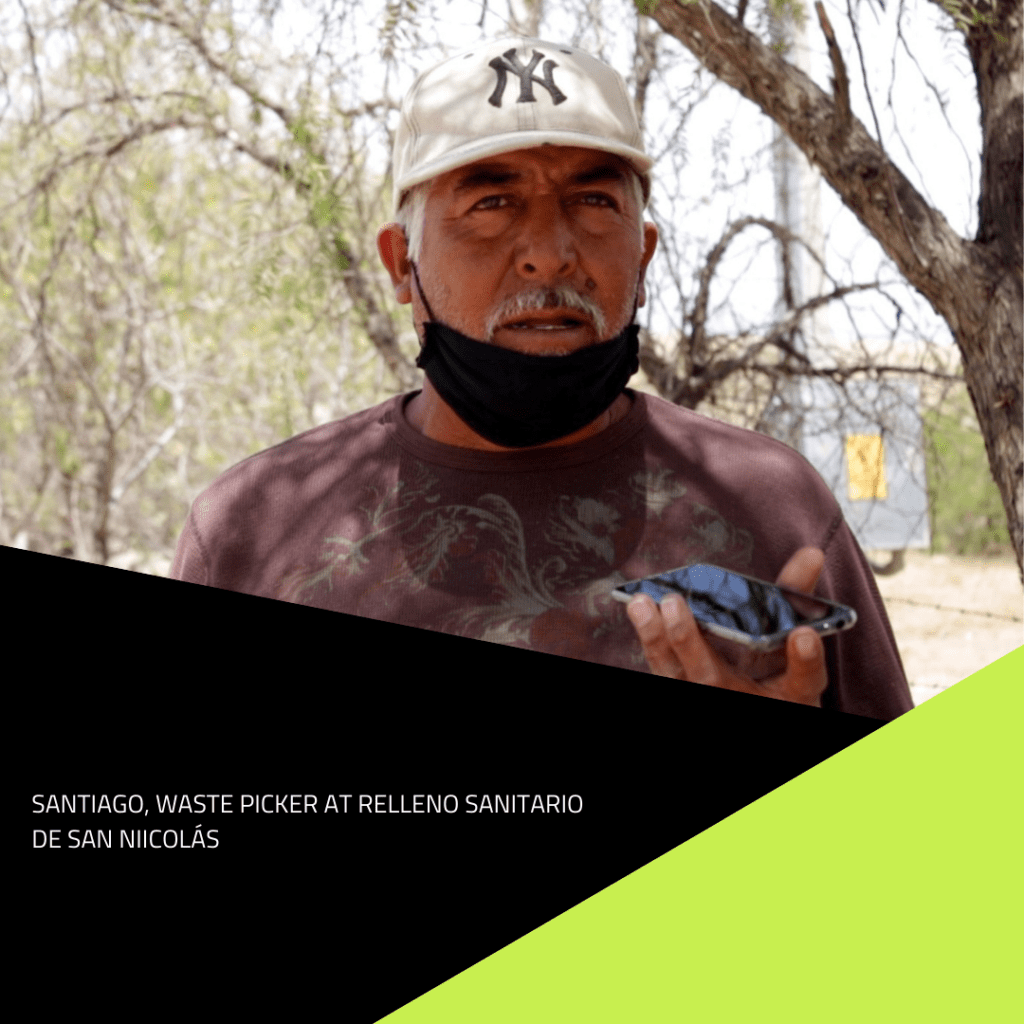
AGUASCALIENTES, Mexico — Saúl started his career as a trash picker, known in Mexico as a pepenador, when he was six years old. Now 60, he makes an independent living by sorting and repurposing materials that the state’s 11 municipalities — total population 1.1 million — dump at the San Nicolás Landfill.

Like many of his 200-some colleagues similarly self-employed here, he plays an important role in a country with a marginal recycling system. But it has been a hard life, with dangerous conditions and low income. Now he’s part of a movement to dignify the lives of these undervalued recyclers.
In 2019, they saw an opportunity for advancement in the Aguascalientes city government’s decision to contract an integrated municipal solid waste firm on-site. However, the deal fell through between the city, the winning bidder PIMSA, and the pepenadores’ collective bargaining representatives.
Para leer este artículo en español haz click AQUÍ
Now, three years after the process began, the pepenadores are no better off than before. They are still ineligible for wages, health insurance and benefits other government employees receive. Exasperated, pepenador Jesús Medrano said:

“They just told us pretty things, what they always say to get you to take the bait: a lunchroom, scholarships for your children, and all that.”
Jesús Medrano
The pepenadores were asking for around 100,000 pesos ($4,800 USD) each in exchange for leaving the recyclables for the private company’s own use and transformation. The CTM and CNOP — confederations that provide savings accounts to the pepenadores who pay dues — negotiated a severance settlement of only 55,000 pesos ($2,600 USD). Even that vanished when the state rescinded PIMSA’s contract for failing to file mandatory paperwork with federal fiscal authorities.
“There were many proposals and only a little share that they offered us to withdraw… We don’t rule out that tomorrow they’ll privatize this landfill. What happened to us opens our eyes to ask for what is fair.”
Santiago Acosta

Click here to see the timeline that details the legal, budgetary, and technical inconsistencies that led to the project’s downfall.

The glaring need remains to attend to the unsalaried service providers who assure that at least some recycling occurs. Yet the plight of the pepenadores is just one of Aguascalientes’ accumulating waste woes. This small, central state’s generation, collection and disposal of urban solid waste has mounted. Currently the estimated average municipal solid waste output here exceeds 1,330 metric tons per day. That’s up from 800 per day in 2001, according to the federal Environment and Natural Resources Secretariat, Semarnat.
The state is far from alone in its predicament. Humberto Tenorio, president of the grassroots Conciencia Ecológica Aguascalientes told The Esperanza Project.
“The plan that the state government had to install a waste plant does not work.” Further, in more than two dozen locations nationwide, similar plans have failed “because the garbage is not separated at the point of origin, so the end result is a stinking mess.” What’s more, he says, “We must reduce our waste!”
Humberto Tenorio
Semarnat says national trash collection provided by paid public services and private government contractors is 83.87 percent; that means more than 16 percent of the nation’s trash is not being picked up. And it’s not getting better; that’s 0.06 percent lower than the rate calculated in 2012. Likewise, 81 percent of final disposal sites have no control over the type and quantity of waste entering them. In other words, hazardous waste could be piling up at locations unauthorized and inadequate to handle it.
Additionally, the federal government’s Basic Analysis for Comprehensive Waste Management shows more than 1,440 final disposal sites (65 percent of the total) concluded their useful life in 2020.
Tenorio says society must shift from a linear to a circular model of production and consumption. This model emphasizes efforts to reduce wasteful design and practice, maximizing the value of all resources – including human resources – in the supply chain. Its workability relies heavily on awareness of the need to rein in the manufacture and use of items that cannot be repurposed.
Article 1 of the General Law for Waste Prevention and Integrated Management states that an information system must be created regarding the generation and integrated management of waste. However, the Contaminated Sites Information System lacks updated information in this area.
Aguascalientes suffers from limited monitoring and innovation for integrated municipal solid waste management policy development. The results are weak citizen participation, clandestine dumps, overflowing garbage containers, and infectious outbreaks amid a pandemic public health crisis.
Some of the institutions and authorities involved in the sector prefer not to generate data for which they would eventually have to take responsibility. The Secretariat of Public Services admits to “not having a record of old urban solid waste disposal sites, due to the constant changes of administration to which it is subjected.”
Saúl, who has spent his life combing the dump sites in person, seems to have a more accurate file in his head. A family member of the CTM’s founders, he affiliated with the union at an early age. He remembers that he began to work in a clandestine dump near his house on the San Pedro River. The garbage was left out in the open because, the owner of the land claimed, “It served as fertilizer for the crops,” Saul says.
From there, Saul picked his way through multiple dumps over the years until he reached the San Nicolás Landfill. He says that back before the landfill, about 20 people used to work in each dump, the trash wasn’t buried like now, and the sites lasted no longer than two or three months.
Zoom in to see a map of the dumps in which Saúl, along with other pepenadores, worked throughout his life.
Some 22 million unsalaried waste sorters the world over handle 30 to 80 percent of the material disposed of in many cities. state-wide, an estimated 6,000 unsalaried recyclers work in the informal sector. As long as society’s throwaway mentality persists, they serve as a bulwark against the loss of valuable resources. Working in the streets and dumps, they capture and repurpose castoff materials.
However, they work without adequate health protection and without social security benefits. They are exposed to a toxic brew of hazardous chemicals and are vulnerable to violations of both human and labor rights. Stigmatized with a history of economic and social marginalization, they seek incorporation into the formal economy by organizing to demand a living wage.
Their industriousness is blazing trails to better health and welfare for their families and their communities. By collecting and separating reusable or recyclable materials of their own accord, they relieve the growing burden of mismanaged municipal solid waste. Inclusive recycling policies aim to incorporate them into the salaried workforce. However, obstacles to their participation abound. Accordingly, grassroots groups are advocating for improved pay and benefits for them while helping consumers reduce and separate their waste.
Arnold Ricalde, a leader of the group Organi-K A.C., says the effort should without a doubt lead to the incorporation of this issue into the National Development Plan and the Federal Government’s Priority Programs and Projects.
In Part 2, The Esperanza Project examines this citizen involvement and its potential for impacting government policy.
*You can find the essentials of this report also published on the website of the Mexican Network of Environmental Journalists (REMPA).
Aguascalientes pepenadores PIMSA recyclers recycling trash pickers
Buen artículo. En hora buena
Hi Diana, the same thing is happening here in Oaxaca. https://www.nvinoticias.com/oaxaca/general/vivir-de-la-basura-250-familias-dependen-del-tiradero-en-zaachila-oaxaca/126979
If you are interested, would be happy to set up a call or email.
Hello Pete, sorry for the delay, i will read your article and you can contact me at [email protected], sure, thanks a lot.